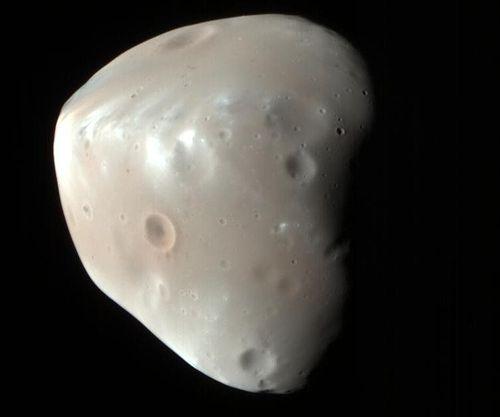
An enhanced-color image of Deimos (MRO, 21 February 2009).
Image: NASA/JPL-Caltech/University of ArizonaDiscovery Discovered by Asaph Hall Discovery date 12 August 1877 Designations Adjectives Deimosian Orbital characteristics Epoch 2012-Sep-21 (JD 2456191.5) Periapsis 23455.5 km[1] Apoapsis 23470.9 km[1] Semi-major axis 23463.2 km[2] Eccentricity 0.00033[2] Orbital period 1.263 d[2] (30.312 h) Average orbital speed 1.3513 km/s[3] Inclination 0.93° (to Mars's equator) 1.791° (to the local Laplace plane)[2] 27.58° (to the ecliptic) Satellite of Mars Physical characteristics Dimensions 15 × 12.2 × 11 km[4] Mean radius 6.2 ± 0.18 km[5] (0.97316 mEarths) Surface area 495.1548 km2[6] (97.0755 µEarths) Volume 999.78 km3[7] (92.2979 nEarths) Mass 1.4762×1015 kg[3] (24.7179 nEarths) Mean density 1.471±0.166 g/cm3[5] Surface gravity 0.003 m/s2[3] (306 µg) Escape velocity 5.556 m/s (20 km/h)[3] Rotation period Synchronous[2] Albedo 0.068 ± 0.007[5] Temperature ≈ 233 K Apparent magnitude 12.45 ± 0.05 [5]
Deimos (systematic designation: Mars II)[8] is the smaller and outermore of the two natural satellites of the planet Mars with a mean radius of 6.2 km,[2] the other being Phobos. Deimos takes 30.3 hours[2] to orbit Mars.
Discovery[]
Deimos was discovered by Asaph Hall, Sr. at the United States Naval Observatory in Washington, D.C on 12 August 1877, at about 07:48 UTC (given in contemporary sources as "11 August 14:40" Washington mean time, using an

Deimos (Viking 2, 5 October 1977).[9]
astronomical convention of beginning a day at noon, so 12 hours must be added to get the actual local mean time).[10][11][12][13] Hall also discovered Phobos on 18 August 1877, at about 09:14 GMT, after deliberately searching for Martian moons.
It is named after Deimos, a figure representing dread in Greek Mythology.[8] The names, at first spelled Phobus and Deimus, were suggested by Henry Madan (1838–1901),[8] Science Master of Eton, from Book XV of the Iliad, where Ares (the Roman god Mars) summons Dread (Deimos) and Fear (Phobos).[14]
Physical characteristics[]

The Deimosian surface from 30 km (Viking, 1977).[1
Deimos, like Mars's other moon, Phobos, has spectra, albedos and densities similar to those of a C- or D-type asteroid. Like most bodies of its size, Deimos is highly non-spherical with triaxial dimensions of 15 × 12.2 × 11 km[4] making it 0.56 times the size of Phobos. Deimos is composed of rock rich in carbonaceous material, much like C-type asteroids and carbonaceous chondrite meteorites. It is cratered, but the surface is noticeably smoother than that of Phobos, caused by the partial filling of craters with regolith. The regolith is highly porous and has a radar-estimated density of only 1.471 g/cm3.[16] The two largest craters, Swift and Voltaire, each measure about 3 km (1.9 mi) across.
It has an escape velocity of 5.6 m/s[3] and apparent magnitude of 12.45.[5]
Named geological features[]
Only two geological features on Deimos have been given names. The craters Swift and Voltaire are named after writers who speculated on the existence of two Martian moons before Phobos and Deimos were discovered.[17]
| Crater | Named after | Coordinates | Diameter (m) | Swift | Jonathan Swift | 12.5°N 358.2°W | 1000 |
|---|---|---|---|---|---|---|---|
| Voltaire | Voltaire | 22°N 3.5°W | 1900[19] |
Orbital characteristics[]
Deimos's orbit is nearly circular and is close to Mars's equatorial plane. Deimos, Mars's outer moon, is possibly an asteroid that was perturbed by Jupiter into an orbit that allowed it to be captured by Mars, though this hypothesis is still controversial and disputed.[20]

Orbits of Phobos and Deimos (to scale).
Both Deimos and Phobos have very circular orbits which lie almost exactly in Mars's equatorial plane, and hence a capture origin requires a mechanism for circularizing the initially highly eccentric orbit, and adjusting its inclination into the equatorial plane, most likely by a combination of atmospheric drag and tidal forces,[21] although it is not clear that sufficient time was available for this to have occurred for Deimos.[20]

Curiosity's view of the Mars moons: Phobos passing in front of Deimos - in real-time (video-gif, 1 August 2013).
As seen from Mars, Deimos would have an angular diameter of no more than 2.5 minutes (sixty minutes make one degree), one twelfth of the width of the Moon as seen from Earth, and would therefore appear almost star-like to the naked eye.[22] At its brightest ("full moon") it would be about as bright as Venus is from Earth; at the first- or third-quarter phase it would be about as bright as Vega. With a small telescope, a Martian observer could see Deimos's phases, which take 1.2648 days (Deimos's synodic period) to run their course.[22]
Unlike Phobos, which orbits so fast that it actually rises in the west and sets in the east, Deimos rises in the east and sets in the west. However, the Sun-synodic orbital period of Deimos of about 30.4 hours exceeds the Martian solar day ("sol") of about 24.7 hours by such a small amount that 2.7 days elapse between its rising and setting for an equatorial observer.
Because Deimos's orbit is relatively close to Mars and has only a very small inclination to Mars's equator, it cannot be seen from Martian latitudes greater than 82.7°.
Solar transits[]
Deimos transits the Sun - as viewed by the Mars Opportunity rover (4 March 2004).
Main article: Transit of Deimos from Mars
Deimos regularly passes in front of the Sun as seen from Mars. It is too small to cause a total eclipse, appearing only as a small black dot moving across the Sun. Its angular diameter is only about 2.5 times the angular diameter of Venus during a transit of Venus from Earth. On 4 March 2004 a transit of Deimos was photographed by Mars Rover Opportunity, and on 13 March 2004 a transit was photographed by Mars Rover Spirit.